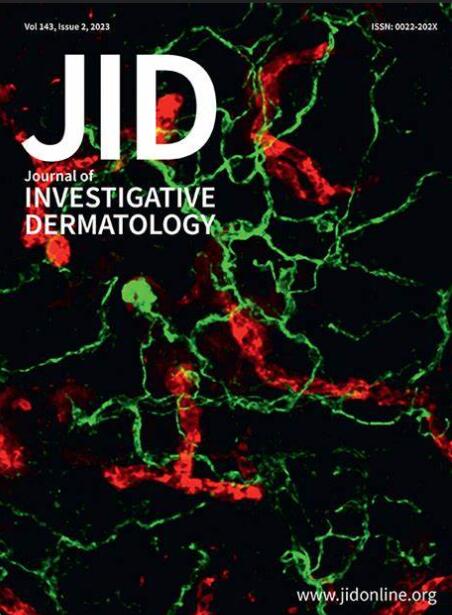The Influence of Melanoma Extracellular Vesicles on Benign Melanocytes: A Role for PRAME in Modulation of the Tumor Microenvironment
IF 5.7
2区 医学
Q1 DERMATOLOGY
引用次数: 0
Abstract
Melanoma is an aggressive skin cancer with a high tendency for metastasis and resistance to conventional therapies. This study explores the role of preferentially expressed antigen in melanoma (PRAME), a cancer-testis antigen, in melanoma progression, focusing on its function in melanoma-derived extracellular vesicles (EVs) and its impact on benign melanocytes. We show that PRAME is highly expressed in melanoma cell lines, tissues, and patient plasma and is present in EVs. These EVs transfer PRAME protein and mRNA to benign melanocytes, leading to significant alterations in gene expression, increased cell proliferation, and a more malignant phenotype. Knockout of PRAME in melanoma cells reduces these protumorigenic effects on melanocytes, emphasizing PRAME’s role in EV-mediated communication. The detection of PRAME in plasma EVs suggests its potential as a biomarker for monitoring disease progression and therapy response, including in rare melanoma subtypes. These findings highlight PRAME as a key player in melanoma progression and suggest targeting PRAME-containing EVs as a potential therapeutic strategy to inhibit melanoma progression and metastasis.
黑色素瘤细胞外囊泡对良性黑色素细胞的影响:PRAME在肿瘤微环境调节中的作用
黑色素瘤是一种侵袭性皮肤癌,具有较高的转移倾向和对传统治疗的耐药性。本研究探讨了前列腺癌抗原PRAME(黑色素瘤优先表达抗原)在黑色素瘤进展中的作用,重点研究了其在黑色素瘤来源的细胞外囊泡(EVs)中的功能及其对良性黑色素细胞的影响。我们发现PRAME在黑色素瘤细胞系、组织和患者血浆中高度表达,并且存在于ev中。这些ev将PRAME蛋白和mRNA转移到良性黑色素细胞,导致基因表达的显著改变,细胞增殖增加,以及更恶性的表型。在黑色素瘤细胞中敲除PRAME可减少这些对黑素细胞的促瘤作用,强调PRAME在ev介导的通讯中的作用。血浆EVs中PRAME的检测表明其有潜力作为监测疾病进展和治疗反应的生物标志物,包括在罕见的黑色素瘤亚型中。这些发现强调了PRAME在黑色素瘤进展中的关键作用,并建议靶向含有PRAME的ev作为抑制黑色素瘤进展和转移的潜在治疗策略。
本文章由计算机程序翻译,如有差异,请以英文原文为准。
求助全文
约1分钟内获得全文
求助全文
来源期刊
CiteScore
8.70
自引率
4.60%
发文量
1610
审稿时长
2 months
期刊介绍:
Journal of Investigative Dermatology (JID) publishes reports describing original research on all aspects of cutaneous biology and skin disease. Topics include biochemistry, biophysics, carcinogenesis, cell regulation, clinical research, development, embryology, epidemiology and other population-based research, extracellular matrix, genetics, immunology, melanocyte biology, microbiology, molecular and cell biology, pathology, percutaneous absorption, pharmacology, photobiology, physiology, skin structure, and wound healing

 求助内容:
求助内容: 应助结果提醒方式:
应助结果提醒方式:


